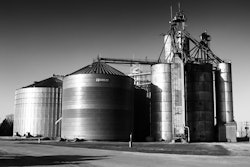
Agriculture must produce 70% more food by 2050, according to the Food and Agriculture Organization of the United Nations. Even modern technology and an evolving workforce will need help in order for the agriculture industry to reach its full potential and feed the future population.
Universities and agribusinesses recognize this demand and are working toward preparing the next generation to produce the world’s food supply through an education in feed science. Kansas State University is one of few schools that offers this specialized degree; however several other universities now incorporate feed mill operations into the classroom experience.
Iowa State plans feed mill
Dr. Charles Hurburgh, professor of Agricultural and Biosystems Engineering at Iowa State University, is one of the driving forces behind constructing a centralized feed mill near Iowa State’s campus.
“It started as a result of a discussion with the integrated hog industry and our animal science department,” Hurburgh said. “Our animal science advisory committee said that students weren’t graduating with enough knowledge of grain or feed handling and management.”
Erin Bowers, post-doctoral research associate at Iowa State, added, “Our decision to do this was almost out of need. It was an investment that would pay off really well in the long run and it would serve students incredibly well.”
Hurburgh, Bowers, and Dr. Maynard G. Hogberg, Professor Emeritus at Iowa State, teamed up to start the planning process for the mill. Students will be the primary workforce at the mill; however several full-time staff will oversee student employees. Plans are in the works for creating a minor in feed mill management.
“We envision the mill will be used in anywhere from one- to four-day workshops for industry and extension or community housed agriculture programs,” Hurburgh said. “The whole issue of feed and food safety is probably the No. 1 topic of discussion in the grain and feed industry, and you can expect that the design of our mill will have essentially the latest electronic and other monitoring devices.”
Northern Crops Institute training mill
North Dakota State University and the Northern Crops Institute utilizes a newly renovated feed production center to allow for hands-on expanded learning opportunities and training. In addition to short-course delivery and technical assistance, Dr. Kim Koch, feed production center manager for the Northern Crops Institute, serves as an adjunct faculty member in the animal science department at NDSU and instructs a feed manufacturing technology course.
Students taking his course can expect to spend upward of one-third of the class time engaged in hands-on training at the feed mill.
Through equipment and technology donations, industry support made it possible for those attending NCI short courses and students attending NDSU to spend class time at NCI’s feed mill. While many universities see the need to educate students in feed and grain sciences, they lack the resources to build a working feed mill.
“It’s becoming quite apparent that we need more and more people in the industry,” Koch said. “We’re going to have to find creative ways to supply that industry.”
An online certificate is one way to accomplish that. Koch is pushing for an online accreditation program that would allow students across the world to take online courses and receive hands-on training in a location nearby.
While online accessibility will provide an easier route to feed education for those who are seeking it, there are still plenty of people unaware of feed industry jobs that need filling or that the field even exists.
Engaging the 98%
But how can the industry engage individuals without an agricultural background?
According to the USDA National Institute of Food and Agriculture, only 35,000 graduates will be available to fill 60,000 high-skill agriculture job openings in coming years. Therefore, an incredible number of jobs will be open to graduates earning degrees outside of agriculture.
The demographics of the workforce will undergo huge changes as the baby-boomer generation retires over the next decade. Hurburgh believes that there are huge opportunities to come for young agriculturalists.
“In 10 or 15 years if you are at a meeting with grain and feed industry people, you’ll see a lot different makeup of folks,” Hurburgh said.
Bowers serves as an example of an individual who did not come from an agriculture background. She became involved as a result of her Ph.D research at Iowa State, which dealt with mycotoxins in crops. It was through Hurburgh’s wife, who also works for ISU Extension in Value Added Agriculture, that Bowers became involved directly with Hurburgh, and she now is a huge part of planning for Iowa State’s new centralized feed mill.
This will become the new norm, according to Brian Rittgers, director of global management development and coaching for Elanco Animal Health.
“A wide difference in people’s background is going to be the hallmark of the future in agriculture where historically agriculture has tended to be pretty uniform,” Rittgers says.
Perhaps agriculture cannot claim to have the most diverse workforce, but progress is evident.
Kansas State University’s College of Agriculture increased enrollment by 1,000 students, reaching 2,780 in 2014. In addition, Iowa State’s College of Agriculture and Life Sciences boasts an 83% increase in enrollment in the last decade.
“I think when you look at the workforce in agriculture, we need people that represent the population,” said Hurburgh. “We have really started to take a holistic approach to looking at everybody as potential employees.”
With less than 2% of the population involved in production agriculture, there is a growing disconnect between the agriculture industry and the public. Some see this as a problem, yet Rittgers is convinced that someone without an agriculture background can be very successful in the industry.
“Agriculture is more than just agriculture; it’s food, it’s science, it’s engineering,” Rittgers said.
It’s also the fastest growing section of the global economy. Thanks to ethanol, agriculture is now involved in the fuel business, too.
“Traditionally agriculture has not been viewed as a growth oriented career,” Hurburgh said. ”A lot of that has started to change.”
Hurburgh acknowledges that organizations must market toward students uninvolved in agriculture to successfully recruit them.
“I think it’s more of a marketing challenge to let people know when you come into agriculture that you don’t have to have grown up on a farm; you don’t have to know how to disassemble a tractor and put it back together again to be viable in agriculture,” Hurburgh said.
Hurburgh said young people need to understand that technology is changing the type of work needed in agriculture and that it’s not going to be what people typically associate with agriculture.
“The definition of work is going to change; thanks to technology, work is not going to be the same,” Hurburgh said. “We don’t need the manual labor that we did before, but I don’t think there is any less motivation to be successful in agriculture”
The next generation may find motivation in being part of something that gives back to society.
“Think about biotech crops and precision agriculture; those aren’t heavy lifting jobs but they are new and make huge contributions to the industry,” Bowers said.
Sell the jobs
In order to succeed in recruiting youth outside of agriculture into the industry, companies must share why they are a great place to work. Rittgers advised employers and companies to “develop a compelling story and vision for who you are and what you do.”
USA Today published an article titled “Want a job? Agriculture industry teeming with them,” and a Georgetown University study found that graduates with agriculture degrees had the lowest unemployment rates of any industry. Despite all the negative press the conventional agriculture industry gets, Rittgers stresses the importance of sharing the vast possibilities ahead.
“We’re going to have so many more opportunities and needs to fill to provide people with affordable, nutritious food,” Rittgers said. “I’m more excited about the opportunities today than ever.”

















